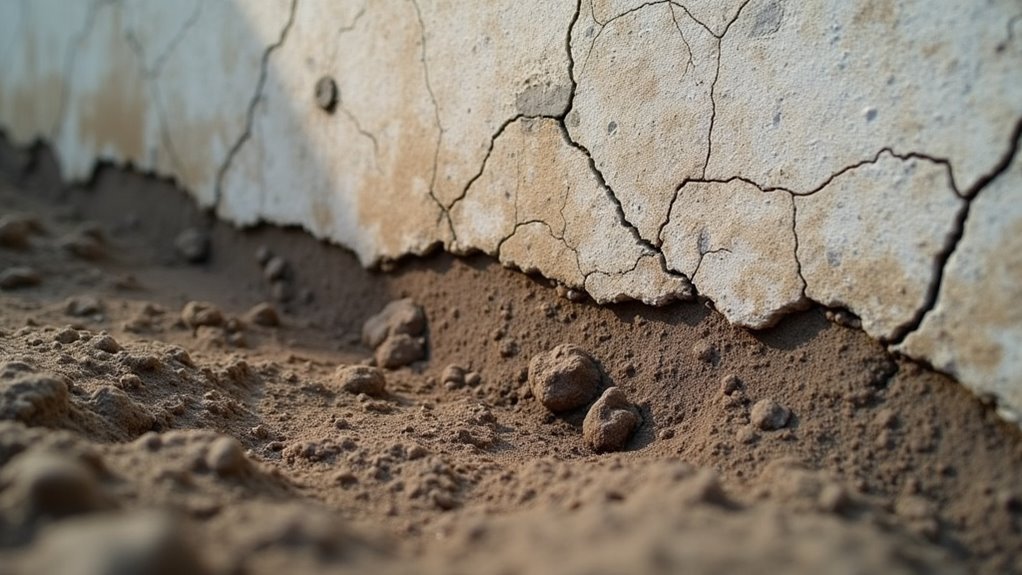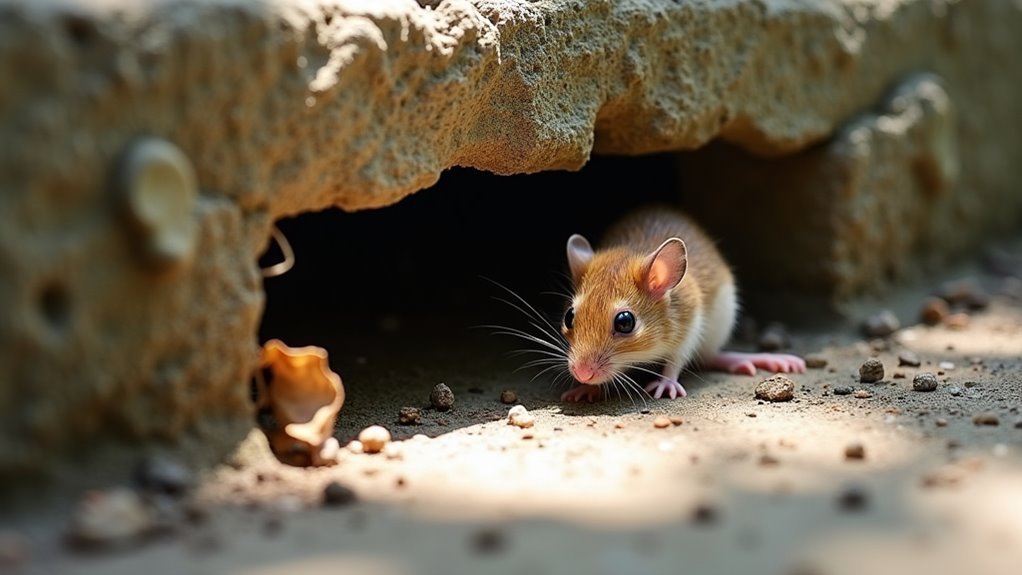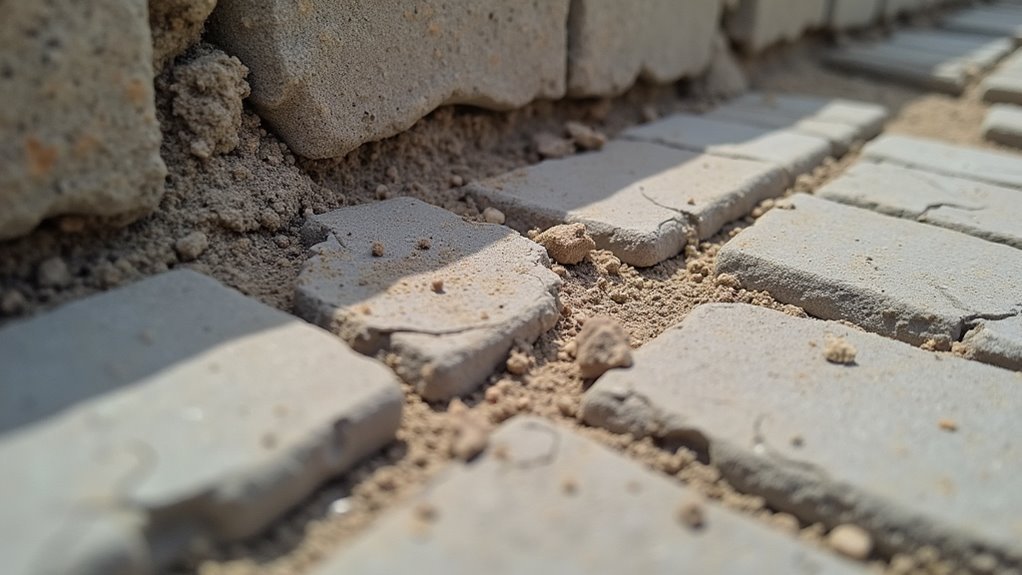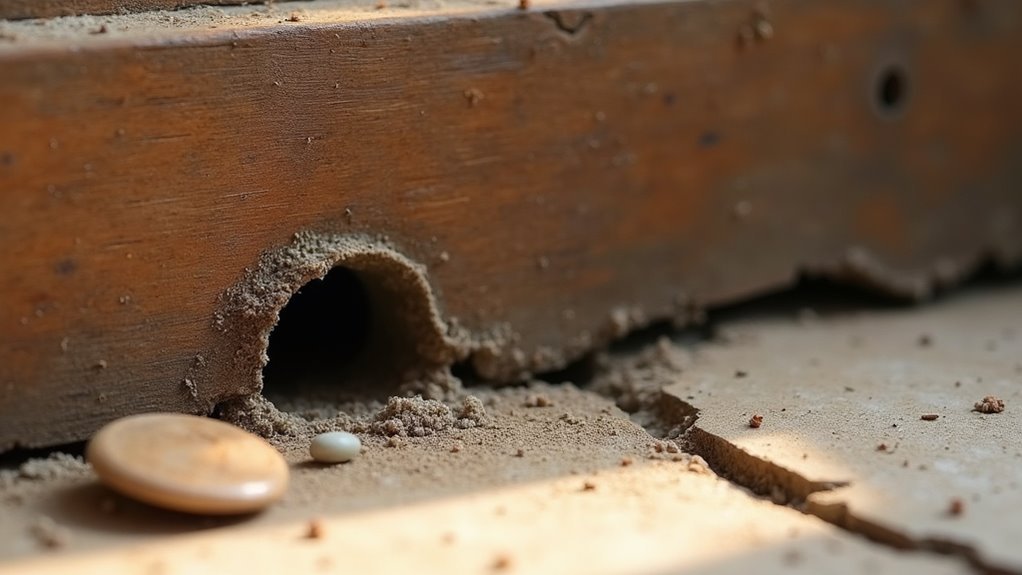You’ll spot mouse foundation entry points by checking seven critical areas: foundation cracks and settlement points where shifting creates gaps, utility penetrations for cables and pipes that often have oversized holes, foundation-to-siding connections where materials separate, basement window wells with deteriorated frames, foundation vents with loose covers or damaged screens, crumbling mortar between foundation blocks, and fresh chew marks around vulnerable joints. These systematic inspections will reveal exactly where mice gain access to your home’s interior.
Check Foundation Cracks and Settlement Points

When inspecting your home for potential mouse entry points, start with your foundation since even quarter-inch cracks provide easy access for these persistent rodents.
Walk around your home’s perimeter and carefully inspect the foundation for any visible cracks or gaps. Pay particular attention to corners and joints where different materials meet, as these areas frequently develop openings.
Settlement points require special attention since foundation shifting creates gaps that mice exploit. Look for areas where the foundation has moved or where erosion has occurred around the base.
Once you’ve identified cracks or gaps, seal them immediately using caulk or expandable foam. Don’t delay repairs—even seemingly minor openings provide sufficient space for mice to squeeze through and access your home’s interior.
Inspect Areas Where Utilities Enter the Foundation
You’ll find that utilities entering your foundation create some of the most overlooked entry points for mice.
Cable and wire penetrations, pipe entries, and HVAC line gaps often have small spaces around them that weren’t properly sealed during installation.
These areas require your close attention since they’re common weak spots where mice can squeeze through surprisingly tight openings.
Cable and Wire Penetrations
Since utility lines must penetrate your home’s foundation to provide essential services, these entry points create perfect pathways for mice if left unsealed.
Cable and wire penetrations are particularly vulnerable because contractors often drill holes larger than necessary, leaving gaps around utility lines that mice can exploit.
You’ll need to thoroughly inspect where cable, internet, and electrical wires enter your foundation. Even openings as small as 1/4 inch provide enough space for mice to squeeze through.
- Use weatherproof caulk combined with rodent-proof sealant around all cable and wire entry points
- Check for signs of wear or damage during seasonal inspections
- Seal any gaps immediately, as mice quickly discover and exploit these vulnerabilities
Regular maintenance prevents these essential utility entry points from becoming mouse highways into your home.
Pipe Entry Vulnerabilities
Plumbing and gas lines create some of the most overlooked entry points in your home’s defense against mice.
You’ll need to inspect areas where these utility lines penetrate your foundation walls, as contractors often leave small gaps during installation. Focus on points where water pipes, gas lines, and heating ducts enter through foundation walls or basement floors.
Look carefully for signs of gnawing around these openings – fresh wood shavings or teeth marks indicate active mouse activity.
Even pinhole-sized gaps around utility lines can accommodate a determined mouse. Seal any discovered openings immediately with weatherproof caulk or steel wool followed by expansion foam.
Make this inspection part of your seasonal home maintenance routine, checking the integrity of existing seals regularly.
HVAC Line Gaps
While plumbing lines present considerable vulnerabilities, HVAC systems create equally problematic entry points that deserve your immediate attention.
HVAC line gaps form where air conditioning and heating lines penetrate your foundation, creating direct highways for mice to enter your home. Even tiny openings allow these persistent rodents to squeeze through and establish nests inside your walls.
You’ll need to thoroughly inspect these vulnerable areas and seal any discovered gaps with weatherproof caulk or specialized rodent-proof sealant.
- Check all visible gaps around HVAC lines entering your foundation walls
- Apply weatherproof caulk or rodent-proof sealant to fill identified openings completely
- Regularly inspect seal integrity and insulation around utility lines for wear damage
Proper line fitting and intact protective covers minimize your mouse entry risks considerably.
Examine Foundation-to-Siding Connection Zones
When inspecting your home’s exterior for mouse entry points, foundation-to-siding connection zones demand your closest attention.
These critical junctions are vulnerable spots where mice often gain access through small gaps and structural separations. You’ll need to examine corners where different materials meet, as these areas typically have less secure connections and more susceptible openings.
Use a flashlight to illuminate dark foundation-to-siding areas, making it easier to identify cracks and crevices that signal potential vulnerabilities.
Look for signs of wear and tear, including separation between foundation and siding materials that create entry points for rodents.
Once you’ve identified problematic areas, seal gaps immediately using appropriate materials like caulk or steel wool to prevent mice from exploiting these structural weaknesses.
Look for Gaps Around Basement Window Wells

You’ll need to carefully inspect your basement window wells, as these areas frequently develop deterioration that creates perfect mouse entry points.
Check the structural integrity of the well walls, frames, and surrounding materials for any signs of cracking, rotting, or separation that could provide access.
Once you’ve identified these vulnerable spots, you can effectively seal well gaps using appropriate materials to block potential rodent infiltration.
Window Well Deterioration
Since basement window wells sit below ground level, they’re particularly vulnerable to deterioration that creates perfect entry points for mice. When you inspect these areas, you’ll often find cracks, gaps, and structural weakening that rodents exploit.
The constant exposure to moisture, freeze-thaw cycles, and ground pressure makes window wells prime targets for damage.
Key deterioration signs to watch for:
- Cracked or crumbling concrete around the well perimeter that creates gaps mice can squeeze through
- Loose or missing mortar joints between blocks or stones that offer direct access routes
- Corroded or damaged metal wells with holes, rust spots, or separated seams
Don’t overlook moisture damage and rot around wooden frames, as these conditions weaken structures and create additional vulnerable access points for persistent rodents.
Sealing Well Gaps
Start your inspection at ground level where the window well meets your home’s foundation, as this junction creates the most vulnerable sealing points for mouse entry.
You’ll want to inspect openings as small as 1/4 inch, since mice can squeeze through surprisingly tiny gaps. Check for signs of rot or moisture damage that can worsen existing vulnerabilities around window wells.
Once you’ve identified problem areas, use caulk or expandable foam to seal gaps effectively. These materials create barriers that prevent mice from accessing your basement.
Don’t forget to clear debris from window wells, as accumulated materials provide additional entry opportunities.
Regular monitoring is essential since weather changes affect structural integrity and sealing effectiveness over time, potentially creating new mouse access points.
Search for Openings Near Foundation Vents
Foundation vents represent some of the most vulnerable entry points where mice can infiltrate your home’s defenses. You’ll need to inspect these areas thoroughly, checking for gaps, cracks, and loose covers that rodents exploit.
Pay attention to dryer vents and crawl space openings where mice often find easy access.
When examining foundation vents, focus on these critical areas:
- Vent covers and screens – Verify they’re secure and free from damage that creates openings
- Surrounding framework – Look for cracks or gaps where the vent meets your foundation
- Debris accumulation – Remove leaves, dirt, and materials that create hiding spots or structural weak points
Install fine mesh hardware cloth over vents to maintain airflow while blocking rodent entry points.
Regular monitoring keeps these protective barriers effective against unwanted intrusions.
Identify Deteriorated Mortar Between Foundation Blocks

Between your foundation blocks, deteriorated mortar creates perfect highways for mice seeking entry into your home.
You’ll need to inspect these joints carefully, as gaps as small as 1/4 inch provide sufficient space for rodents to squeeze through. Use a putty knife to probe the mortar between blocks – if it crumbles easily under pressure, you’ve found a potential entry point for mice.
Check for signs of moisture or water damage around your foundation, which accelerates mortar deterioration. Look for cracks, crumbling sections, or areas where the mortar has completely fallen away.
Once you’ve identified compromised areas, seal gaps immediately using appropriate caulk or fresh mortar mix. This proactive approach eliminates access routes before mice discover them, protecting your home from unwanted rodent intrusions.
Spot Chew Marks and Fresh Gnaw Damage on Foundation Materials
While examining your foundation’s exterior, you’ll discover telltale chew marks that reveal active mouse presence around your home’s perimeter.
These distinctive marks appear as quarter-inch wide gouges on wood, concrete, or other foundation materials. Fresh gnaw damage stands out with lighter-colored surfaces that contrast sharply against weathered materials, making identification straightforward.
Fresh mouse gnaw marks create distinctive quarter-inch gouges with lighter surfaces that stand out against weathered foundation materials.
Focus your inspection on these critical areas to spot chew marks effectively:
- Foundation seams and cracks – Check where different materials meet, as mice target these vulnerable joints.
- Material junctions – Examine areas where wood meets concrete or where utility lines enter foundations.
- Debris accumulation zones – Look for shredded insulation fragments near potential entry points.
Always search for mouse droppings near suspected gnaw damage to confirm active infestations around these entry points.
Frequently Asked Questions
How to Find Out Where Mice Are Entering a House?
You’ll discover mouse entry points by inspecting your foundation for quarter-inch cracks, checking utility openings for droppings, examining vent covers, evaluating garage weather stripping, and looking for gaps around doors and windows.
How Do You Block Mice Entry Points?
You’ll block mice entry points by stuffing steel wool into small holes, sealing larger gaps with caulk or concrete, replacing damaged weather stripping, and using copper mesh for tiny openings throughout your home’s exterior.
Where Is the Most Common Place Mice Enter the House?
You’ll find mice most commonly enter through foundation cracks, even those as small as 1/4 inch. They’re also frequent entry points around utility lines where gaps develop unnoticed over time.
What Do Mouse Entry Points Look Like?
You’ll see small cracks or gaps measuring less than 1/4 inch in your foundation. Look for chewed areas, gnaw marks, and openings where different materials meet that aren’t flush together.
In Summary
You’ll prevent mouse invasions by regularly checking these seven foundation entry points. Don’t wait until you’ve spotted droppings or heard scratching sounds – inspect your foundation monthly and seal any gaps you find immediately. Remember that mice can squeeze through openings as small as a dime, so even tiny cracks need attention. Taking these proactive steps will keep your home mouse-free and protect your family’s health and property from unwanted rodent damage.





Leave a Reply